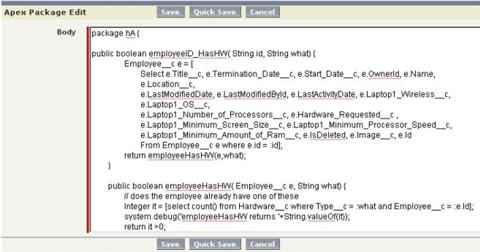Salesforce.com transitions to platform as a service

Salesforce.com plans to make its Apex Code available in general release next month, completing its transition from an on demand CRM application platform to a more generalized on demand software development platform.
In fact, with the forthcoming Summer ‘07 release, salesforce.com now describes itself as a the "world's platform-as-a-service," complete with acronym, PaaS. It would have been more accurate to add the word"programmable."
"The vision for the company is around the platform as service," Collins to me. "We delivered applications as a service with CRM, and now people can create own applications as a service. That's the true benchmark and test of a platform."
Salesforce.com CEO Marc Benioff calls it "programming without software," which is an obtuse way of saying 'code to our platform and run without worrying about any infrastructure issues.'
The Apex development environment gives developers the capability to create a variety of enterprise applications that run on the salesforce on demand infrastructure. "We are popping the top off of our platform, and with the advanced logic and the capability of our programming language, developers can write inventory management, ERP and transactional applications like ecommerce, ” said Kendall Collins, senior vice president of product marketing at salesforce.com, when Apex was introduced in October of last year.

At this point, the company is not heralding any of those breakthrough Apex platform applications.
The platform play is also a business strategy. From the inception of the company, salesforce.com CEO and co-founder, and former Oracle executive, Marc Benioff has wanted to conquer the larger enterprises served by Oracle, SAP and Microsoft rather than focus on the vast small business sector.
Speaking earlier this year about the Apex platform, salesforce.com CEO Marc Benioff said, "We want a killer app to emerge from a third-party. We don't want to do it all ourselves…we can't. It's better to aggregate the whole industry and go at development as a team effort, especially for an distributed environment like AppExchange….We can sell far more seats and at much higher margin over time. As a platform company, we can enter all markets. CRM is only one information management market; there is such a wide area of applications–ERP, custom, custom apps, agile apps. And, the cost and heavy lifting of building apps and the risk associated with developing each additional app for each market and geography is diminished. We share in the success but not in the risk, and the developer doesn’t have to take big risk investing in capital expenditures or taking venture capital money."
According to Collins, a platform-as-a-service requires three key elements.
- Underlying service quality--security, reliability, availability and scalability (SRAS)
- Integration
- Customization
Collins said that salesforce.com consistently provides above 99.9 percent availability. "Three nines is the best quality of service you can get today from any on demand player," he said, claiming that the best deployments of Siebel and Oracle are closer to 96- to 97-percent available.
In any case, as salesforce.com scales up the enterprise and companies have more dependence than for just CRM on its platform, three nines, which doesn't include times when the service is up but suffers performance problems, won't be sufficient for customers who can't afford 8.76 hours of downtime a year.
On the integration front, the salesforce/Apex platform has been successful, with more than 50 percent of the 4.2 billion transactions in the first quarter handled by the Salesforce Web Services API.
Customization is core to salesforce.com's platform transition, moving from changing a field to writing to code to deliver any kind of application, Collins said.
In addition, the Summer '07 release includes some enhancements to its workflow component, renaming it Enterprise Intelligent Workflow and adding the capability to add Excel-like formulas as part of the workflow management. Customers can also deploy multiple Salesforce Sandboxes, which give companies a place outside of their production environment for testing, training and development.